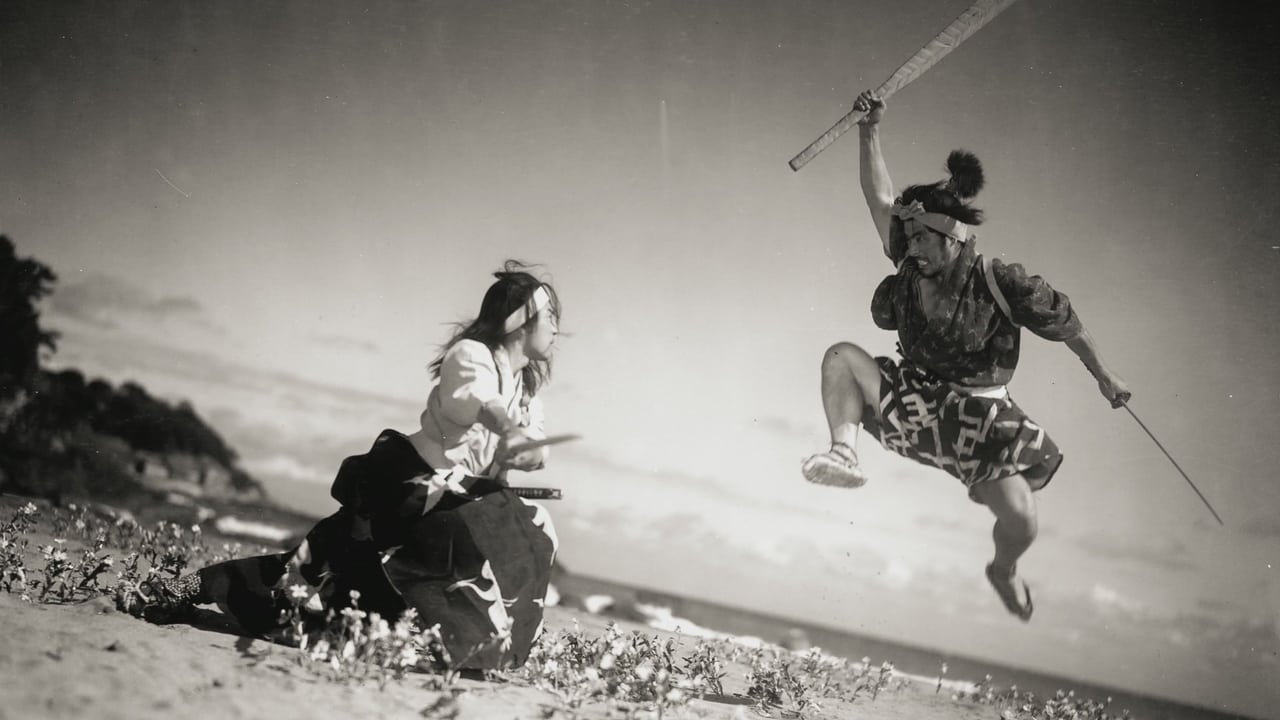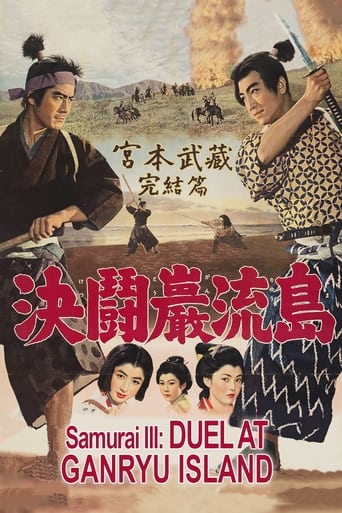

The first two movies of the series "Miyamoto Musashi" and "Zoku Miyamoto Musashi: Ichijôji no kettô" were already ones that was very little wrong with but this movie is basically even a better one, one basically every front thinkable.The movie its story flows way better, which is probably also due to the fact that lots of things finally get wrapped up in this movie and there also is more action to enjoy this time. By todays standards it perhaps is still a pretty slow movie to watch but still the pace and flow within this movie was something I wasn't quite expecting from this movie, especially since the first two movies weren't as fast going or well flowing as this one was. The movie really felt and also looked as if it got made by an entirely different cast and crew this time, while this of course was not the case. Perhaps it was due to the fact that "Miyamoto Musashi" and "Zoku Miyamoto Musashi: Ichijôji no kettô" got made almost back-to-back, while before this movie director Hiroshi Inagaki also had go on and directed a totally different movie, "The Lone Journey".The fight sequences do not disappoint within this movie. This is basically what the entire trilogy was building up toward. It's end fight has become quite legendary over the years and is a beautiful looking done one.The whole trilogy definitely benefits from the fact that it got shot in full color. It's natural environments and sets are all beautiful looking and its visual look is actually one of the reasons why the whole trilogy is liked so much and still quite popular to watch, over 50 years later now.More of a 'modern' movie than any of its two predecessor and definitely better flowing with its story and characters, also definitely due to the movie its action. A perfect conclusion for the trilogy.9/10http://bobafett1138.blogspot.com/
... View MoreThis film is the final installment of director Hiroshi Inagaki's "Samurai Trilogy," three films covering the life of Musashi Miyamoto (Takezo,) Japan's most famous swordsman of the early 17th century and perhaps of all time.He was an icon of the warrior-philosopher model. He survived numerous duels to the death and retired to painting and writing. His best known work is the "Book of Five Rings," a book which gained popularity recently when it was championed by the Harvard Business School.All three films of Inagaki's trilogy, made in 1954, 1955, and 1956, are part of the elite Criterion Collection of classic films.Briefly, this movie resolves the conflict of the two women in Takezo's life, Otsu and Akemi, and leads up to Musashi's showdown with the second most famous swordsman of the day, Sasaki Kojiro. This is the famous Duel at Ganryu Island of the title.Although I cannot appreciate the Japanese language and must rely on the English subtitles for the meaning of dialog, I do appreciate the beauty of this early widescreen color film. (I believe Tojoscope is a Japanese version of cinemascope.) One could take almost every frame of this film and it would make a stunning still. The costumes and the sets reflect an attention to detail of color, lighting and composition.For its sense of rather understated action, I particularly enjoyed the opening scene. Sasaki Kojiro demonstrates his signature Swallowtail Turn, a move whereby he severs the tail feathers of this notably swift and agile bird in flight. It's not the portrayed animal cruelty that I enjoyed; it's the human quickness and skill that would be required to accomplish such a feat. I certainly hope that no birds were actually harmed in the making of the film.
... View MoreI just don't get why in Japanese movies women are just really 2 different characters. They are either A) the incredibly weak woman that would rather die than be without her love when she doesn't even really have a reason to love this guy or B) the conniving backstabbing evil of the world people. Otsu is A, all the other women in this movie are B with Akemi being both A & B. Why the heck does Otsu keep stalking this guy from town to town? Honey, you've been surving pretty well on your own all your life and you're pretty hot for an Asian chick, I'm sure some guy would take pretty good care of you without making you stalk him all over Japan.The romance is weak, very weak, but this is movie from the 50s we're talking about. Nothing in the first two movies really setup why these women are in love with Musashi, they just are cause he's Musasi who happens to be the main character, we're suppose to love him too and not question what makes these women psycho.Musashi's motivations are weak too along with Kojiro's. Why travel around and murder people in town after town when good looking women are inviting you to stay and have a good time? What else is there in life, really??? Even despite being annoyed by the bad romance scenes with DRAG on and on, and everyone in feudal Japan being murdering serial killers this movie is still pretty darn entertaining, and the actions are darn good. Its not close up face shots during the action, instead its well layed out camera work that displays Mifume's physical prowess. The guy is quick. The final duel is a thing of beauty, and is copied by every horrible japanimation cartoon on the face of the planet these days. I hate japanimation.
... View MoreThis is the 3rd and last episode of the "Miyamoto Musashi" or also called "Samourai" trilogy, from director Inagaki with famous Japanese actor Toshiro Mifune. The 1st episode having won the 1956 Oscar award of best foreign movie ! Inagaki's directing is refined and perfect, scenery is beautiful especially the sunset duel, choreography of combats is marvellous. Inagaki's directing and Mifune's great acting bring life to Musashi's legend and depict him with a lot of humanity.This episode has the most significance for Japanese with the famous combat between Miyamoto Mifune, invincible samourai of more than 60 duels armed with a wooden sword, and Sasaki Kojiro, most formidable adversary and skillful swordsman armed with an extremely long sword, on the beach of Ganryu Island at sunset. The trilogy shows the life of Japan's most famous samourai and one of it's main philosopher, with the "Gorin-no-sho" treaty of 5 rings, with his sword techniques and Budhism life philosophy. In summary, the 1st episode is how he becomes an adult man, the 2nd how he becomes an invincible swordsman and the 3rd how he becomes a legend. Subplots being his relationship with Otsu who sacrifices her life for Musashi.This trilogy is among Japan's two samourai masterpieces with Kurosawa's "Seven Samurais", mainly because of the directing/acting and Musashi's aura. Other Must-see Sword movies are recent movie Gohatto (or Tabou, 1999), Kurosawa's "Ame agaru" (After the rain, 1999), "Yojimbo" (The bodyguard) and "Sugata Sanshiro" (The Judo saga).
... View More